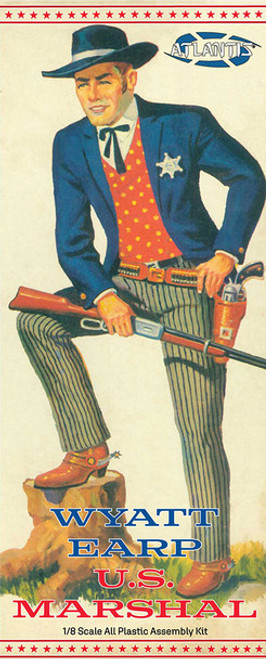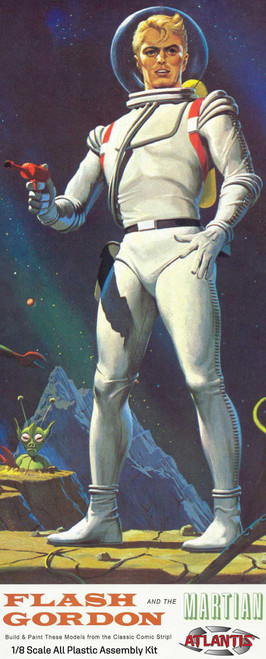Product Description
1/8 Scale. This kit comes from the Pyro Tooling. Comes packaged in the classic Aurora style long box. Stands over 9 inches tall!
About your US Marshal
The office of United States Marshal was created by the First Congress. President George Washington signed the Judiciary Act into law on September 24, 1789. During the settlement of the American Frontier, marshals served as the main source of day-to-day law enforcement in areas that had no local government of their own. From the nation's earliest days, Marshals were permitted to recruit special Deputies as local hires. Marshals were also authorized to swear in a posse to assist with manhunts, and other duties. Individual Deputy Marshals have been seen as legendary heroes in the face of frontier rampant lawlessness such as Wyatt Earp, Bat Masterson, Dallas Stoudenmire, and Bass Reeves. Your model of the US Marshal is based on these Old West examples.
More info written by Rick Delfavero:
Probably the most famous US Marshal to arise in the colorful American 19th century western frontier was Wyatt Earp. He was a saloonkeeper, gambler, lawman, gunslinger, and confidence man but was perhaps best remembered for his participation in the notorious Gunfight at the OK Corral in Tombstone, Arizona in 1881.
Wyatt Berry Stapp Earp was born in 1848 in Monmouth, Illinois. The third of five sons born to Nicholas and Virginia Ann Earp, he spent his early life in Illinois and Iowa. At 17, Wyatt left home and found work hauling freight and grading track for the Union Pacific Railroad. In 1869, he joined his family in Lamar, Missouri. There he married Urilla Sutherland in 1870 and was elected local constable. Within the year his wife died of typhoid while pregnant with their first child. Devastated, he sold his newly bought house and left town to move around the Indian Territory and Kansas.
During this turbulent period, Earp frequented the saloons, gambling houses and brothels that proliferated on the frontier, and had several run-ins with law enforcement. But after helping a police officer in Wichita, Kansas track down a wagon thief, Earp joined that city’s police force in 1875. Later he would become Deputy Town Marshal of Dodge City helping to keep the Cowboys (local outlaws) in line. It was in Dodge City that Earp would make the acquaintance of Bat Masterson and Doc Holliday, a well-known gunman and gambler. It was said that Doc had stepped in to save Wyatt's life in a bar room incident. In 1877, after a brief time chasing the Gold Rush in the Black Hills of Dakota Territory, Wyatt returned to Dodge City and was made City Marshal.
In 1879 Wyatt and Mattie Blaylock, a former prostitute and his companion for several years, traveled to Tombstone, Arizona Territory. Most of the Earp family congregated there after receiving news from Virgil about a huge silver strike. They were joined by Wyatt’s closest friend Doc Holliday and his companion Mary Katherine Cummings, better known as Big Nose Kate. The group is too late to profit from the silver rush, but were involved in buying real estate and businesses. Wyatt became a gambler and a guard in a saloon, and his brother Virgil became Town Marshal.
Wyatt's feud with the Cowboys began in March 1881 when he joined a posse after some Cowboys robbed a Tombstone stagecoach and killed its driver. Many Cowboys were loosely organized criminals connected to a few main families, like the Clantons and the McLaurys. Wyatt struck a deal with local rancher Ike Clanton, who had ties to the Cowboys. Clanton soon turned against him, however, and began threatening the Earp brothers. The feud escalated, and on October 26, 1881, it finally exploded into violence in a gunfight at the OK Corral in Tombstone. The fight pitted Wyatt, his brothers Morgan and Virgil, and Doc Holliday against Ike Clanton, Billy Clanton, Frank McLaury, and Tom McLaury. Frank and Tom McLaury and Billy Clanton were killed; Morgan, Virgil Earp and Doc Holliday were all wounded but survived. Ike Clanton ran away, and Wyatt emerged from the fight unharmed. The gunfight, however, failed to end the feud.
Ike Clanton filed murder charges against the Earp brothers and Holliday, they were arrested and spent 16 days in jail, but a judge cleared them in late November. The Feud Continued in December when Virgil was shot while walking home from a saloon to his hotel, crippling his arm for life. The identities of his attackers remained a mystery.
On December 29, 1881 Wyatt Earp became a Deputy United States Marshal.
The following March, Morgan was killed when unknown gunmen attacked him and Wyatt at a Tombstone saloon. On a hunt for the culprits, Wyatt and his posse subsequently kill at least two suspects, including Frank Stilwell, believing him responsible for Morgan’s death. Over the next few weeks, they search the area for other suspects in Morgan’s murder, killing Florentino “Indian Charlie” Cruz and Curley Bill Brocius, and maybe more. Wyatt was accused of murder, and he fled, moving first to Colorado, then to several boomtowns in the West, and eventually joined his brother Virgil in San Francisco.
He settled there in 1882 with Josephine Marcus, an old acquaintance he met when she was a theatre performer and married to Johnny Behan in Tombstone. They remained together for 47 years until Wyatt’s death in 1929.
Beginning in January 1884, Wyatt and Josie traveled throughout the West, searching for gold and running horse races. Wyatt occasionally acted as a representative of law enforcement, but did not hold any one position for very long. In the fall of 1897 Wyatt and Josie joined others in a gold rush to Nome, Alaska. They ran a saloon and various gambling ventures during their time there.
By 1901 Wyatt and Josie returned to California and began building his legacy. Wyatt staked claims in gold and copper mines near the Whipple Mountains. Over the next few years he supported himself by mining, police work, gambling, and real estate deals.
Wyatt spent several summers in Los Angeles, where he met Hollywood actors and became an adviser on the set of silent Western films. In 1915, Earp visited the set of director Allan Dwan's movie, The Half-Breed, starring Douglas Fairbanks. Earp became friends with William S. Hart and later Tom Mix, the two most famous movie cowboys of their era. Hart was a stickler for realism in his depictions of Western life, and relied on Earp for advice. Earp later frequently visited the sets of movie director John Ford, whose movies starred Harry Carey. In 1916 Earp went with his friend Jack London, whom he knew from Nome, to visit the set of former cowboy, sailor, and movie actor-turned-film director Raoul Walsh. Walsh took the two men to dinner and during the meal, the highest paid entertainer in the world, Charlie Chaplin, dropped by to greet Wyatt Earp.
He worked with John H. Flood, his personal secretary, to write his memoirs, but they received a poor reception during his lifetime. This was mostly due to Flood's "stilted, corny, and one-dimensional" writing.
Wyatt Earp died on January 13, 1929 in Los Angeles, California, at the age of 80.
The first major Earp biography, “Wyatt Earp, Frontier Marshal” by Stuart N. Lake, was published in 1931 and became a bestseller. It established Earp as a folk hero among millions of Americans searching for inspiration and excitement during the hard times of the Great Depression.
The mythic stature of Wyatt Earp as a virtuous lawman and the best gunfighter in the West grew in the decades after his death. He became the subject of numerous TV shows and movies, and has been portrayed by such leading actors as Hugh O'Brian, Henry Fonda, Burt Lancaster, James Garner, Kurt Russell and Kevin Costner.








